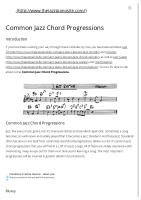Rootless Chord Voicings - The Jazz Piano Site [PDF]
(http://www.thejazzpianosite.com/) Rootless Chord Voicings Chord Voicings In a previous module we learned about the
40 0 193KB
Papiere empfehlen
![Rootless Chord Voicings - The Jazz Piano Site [PDF]](https://vdoc.tips/img/200x200/rootless-chord-voicings-the-jazz-piano-site.jpg)
- Author / Uploaded
- Mbolafab Rbj
Datei wird geladen, bitte warten...
Zitiervorschau
(http://www.thejazzpianosite.com/)
Rootless Chord Voicings Chord Voicings In a previous module we learned about the theoretical aspects of Jazz Chords (http://www.thejazzpianosite.com/jazz-pianolessons/jazz-chords/). In this series of lessons we will be discussing how chords are actually played in practice. This is a very important part of playing Jazz piano. A chord voicing is just a way of altering the order of and intervals between the notes in a chord. So instead of playing CMaj7 as a block chord (C E G B) we could reorder the notes and play C B E G. Playing appropriate chord voicings can make a song sound very jazzy and very professional.
Omitting Notes In previous lessons (speci cally the one on Shell Chords (http://www.thejazzpianosite.com/jazz-piano-lessons/jazzchords/shell-chords/)) we established that in Jazz we don’t need to play every single note in a chord. Speci cally, it’s possible to omit the less important notes (root & 5th). Well, using this same idea, we can create rootless voicings.
Pentatonic Practice Session - Personal practice partner Learn how to play the pentatonic scale effortless all over the fretboard. reiff.dk
Rootless Chord Voicings A smooth and popular type of chord voicing are called (Bill Evans style) Rootless Chord Voicings. As the name suggests, these chord voicings exclude the root note. Instead of the root (and sometimes the 5th) we play chord tensions (http://www.thejazzpianosite.com/jazz-piano-lessons/jazz-
OPEN
chords/extensions-alterations/). This gives us a jazzy sound
(because of the tensions) while not being too crowded (you only ever play 4 notes because we drop the root). Even though we are allowed to omit the root note in a chord, if you’re playing in a band often the bass player will play the root note. Otherwise, there’s nothing wrong with just leaving it out. The root note isn’t really all that important, harmonically speaking. In short, Rootless Chord Voicings are played as follows: For Major and minor chords play: 3rd, 5th, 7th, 9th For V7 chords play: 3rd, 7th, 9th, 13th
There are also two ‘types’ of rootless chord voicings. One is just an inversion of the other (if one has the 3rd on the bottom, the other has the 7th on the bottom). These voicing works really well for II-V-I progressions, because you only need to change a few notes (and by only a small interval) to move from one chord to the next (i.e. there is smooth voice leading). Below is an example of a II-V-I in the key of C using rootless chord voicings. Notice how smoothly each chord transitions to the next. Type A Rootless Voicings Chord
7th Chord in C
Rootless Chord
Notes
Degrees
Note on Bottom
ii
Dm7
Dm9
FACE
3579
3rd
V
G7
G13
FABE
7 9 3 13
7th
I
CMaj7
CMaj9
EGBD
3579
3rd
Type B Rootless Voicings
Chord
7th Chord in C
Rootless Chord
Notes
Degrees
Note on Bottom
ii
Dm7
Dm9
CEFA
7935
7th
V
G7
G13
BEFA
3 13 7 9
3rd
I
CMaj7
C69
ADEG
6935
7th
Chord Ambiguity Notice also, that because we are omitting certain notes, chords become a little ambiguous. Rootless Dm9 (F A C E) = FMaj7 = Am♭6 Rootless G13 (F A B E) = Rootless Dm69 = Rootless D♭7#9♭13 Rootless CMaj7 (E G B D) = Em7 = G6
Notice how all the above chords are substitutes (http://www.thejazzpianosite.com/jazz-piano-lessons/jazzchords/chord-substitution/) for each other (generally Median Note or Tritone substitutes). This is part of the charm of rootless voicings. There are a little ambiguous.
Altered Rootless Voicings As we learned in the lesson on Available Tensions (http://www.thejazzpianosite.com/jazz-piano-lessons/jazzchords/available-tensions/), we can alter the chord tensions (♭9, #11, ♭13, etc.). We can apply this idea to Rootless Chord Voicings. We must keep the 3rd and 7th the same, but we are free to alter the other two notes. So you can create chords like a:
CMaj7#11 (by substituting the 5th for a #11th); C69 (by substituting the 7th for a 6th); Dm69 (by substituting the 7th for a 6th); Dm7♭5 (by attening the 5th).
Left Handed Voicing & Rule of Thumb Rootless voicings are played entirely with the left hand. This means your right hand is free to play the melody or improvise. In future lessons we will also discuss numerous two handed chord voicings. Because you are playing 4 notes all within the span of a single octave, these voicings can be a little bit muddy if played too low. As such, try adhere to the ‘rule of thumb’: the top note of a rootless chord voicing (played with your thumb) should be between middle C and the C an octave above middle C on the piano. That is, try stick to the middle register with this chord voicing.
Jazz Piano History Rootless chord voicings were developed in the 1950’s by pianists like Bill Evans, Wynton Kelly and Ahmad Jamal. Prior to this, Jazz pianists tended to use Shell Chords (like the Bud Powell Voicing (http://www.thejazzpianosite.com/jazz-piano-lessons/jazzchord-voicings/powell-voicings/) we will learn in a future lesson) or Stride Piano.
Have a Listen to
My Foolish Heart ~ Bill Evans version Autumn Leaves ~ Bill Evans version Any and Every Bill Evans song
Jazz Piano Chord Voicings - Left Hand Rootless Voicing
>> NEXT LESSON >> (/jazz-piano-lessons/jazz-chord-voicings/monk-voicings)
Music Lessons in Ballymena - Music Lessons NI Music lessons in Ballymena including Piano lessons, Guitar lessons and more ballymenaschoolofmusic.co.uk
Search The Jazz Piano Site Search …
Donate
While all my lessons are free, if you nd them useful please
consider donating to help keep them coming. (https://www.paypal.com/cgi-bin/webscr? cmd=_donations&business=DUZ6VARAK7VAE&lc=AU&item_name= Walk%20That%20Bass¤cy_code=AUD&bn=PP%2dDonations BF%3abtn_donate_LG%2egif%3aNonHosted) Home (http://www.thejazzpianosite.com) Donate (http://www.thejazzpianosite.com/donate/) Resources (http://www.thejazzpianosite.com/resources/) Privacy Policy (http://www.thejazzpianosite.com/privacy-policy/) Sitemap (http://www.thejazzpianosite.com/sitemap/) Theme by Tesseract (https://tesseracttheme.com)
(https://tesseracttheme.com)









